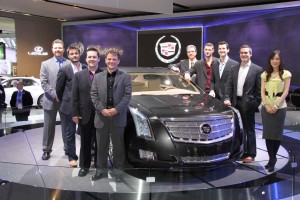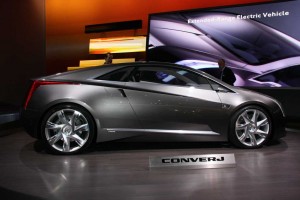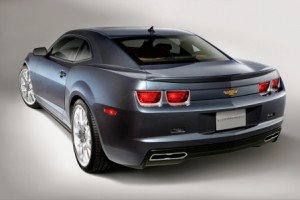
The customer, says GM Vice Chairman Bob Lutz, isn't always right. And sometimes you can't listen to what they say if you want to give them what they actually want.
The customer is always right. Or so goes the old saw. But General Motors Vice Chairman Bob Lutz says it’s not always a good idea to listen to the customer.
Without a clear point of view, a manufacturer risks developing bland products that no one really wants, warned “Maximum Bob,” during a conversation at the 2010 North American International Auto Show. Just consider the last three generations of Cadillac’s once cutting-edge STS sedan.
Until recently, the mantra of GM’s product development process was not to offend anyone, explained Lutz, so the company would look for so-called “dis-satisfers,” and eliminate them from its vehicles. Lutz likened it to the pizza shop that kept eliminating ingredients because someone didn’t like anchovies and someone else didn’t like pepperoni. Eventually, it wound up with nothing but dough.
Each successive generation of the STS, admitted Lutz, became “an increasingly bland car that offended nobody but didn’t turn on anyone,” either.
Since joining the company, nearly a decade ago, the septuagenarian executive has pushed GM planners to take more risks and shoot for more emotional products that have a clear point of view. The test of that will come with the new Cadillac XTS. The model on display at the 2010 Detroit Auto Show is officially described as a concept car, but the open secret is that a production version is fast working its way towards production, and will replace both the STS and the Caddy DTS sedan.
The new flagship four-door isn’t quite as edgy as the smaller Cadillac CTS, but is nonetheless much more angular and distinctive than the older models and shows that the GM luxury brand is ready to call its own design shots rather than follow the trends set by its import competitors.
And it’s not just Cadillac moving in that direction. The new Chevrolet Camaro has won raves since its launch, in mid-2009. It’s one of a handful of new General Motors products that are facing a problem that GM hasn’t experienced much, lately. With demand outstripping supply, the carmaker is looking at ways to boost production of models such as Camaro and the Chevy Malibu midsize sedan. In turn, Lutz and other GM executives say they may soon have to begin hiring to help increase output at some of their plants.
There is also the possibility that one or more idled facilities – such as the former Saturn assembly line in Spring Hill, Tennessee – may get new product.
Not only is demand for the Camaro exceeding GM’s expectations, but so are the profits from the car. To emphasize the high-mileage V6 version, needed to improve GM’s corporate fuel economy numbers, Lutz revealed, the automaker held down the price, while raising the cost of the Camaro V8.
But, unexpectedly, demand has been running 80% V8s, according to Lutz, and the ATP, or average transaction price, for the pony car, has been averaging “$8,000 to $9,000 over the anticipated numbers.”
How long that will continue is unclear, and Lutz also acknowledged that Camaro falls into a class of high-style vehicles that tend to quickly lose their edge as buyers move onto the next new thing, usually within 18 to 24 months. Margins will come down and, the Vice Chairman addedm “We’ll have to do special variants,” such as the upcoming Camaro convertible, to shore up sales.
One of the highest-profile models at this year’s Detroit Auto Show is the Chevrolet Volt, a vehicle that began almost as a lark, a few years back, when Lutz decided GM needed to explore the possibilities of battery power. Due to market late in 2010, Volt is a so-called Extended-Range Electric Vehicle, or E-REV. It will have about 40 miles range on its lithium-ion batteries. Then an internal combustion engine will kick in, permitting a motorist to keep on going.
Last year, GM revealed a concept of what a luxury E-REV would look like, and according to Lutz, formal approval will be given to that second model, dubbed the Cadillac Converj.
The carmaker is also working on more conventional plug-in hybrids, which will also permit drivers to operate on battery power alone, though for shorter distances than Volt and Converj. Those should be ready for market by 2012 or so.
And a separate GM source told TheDetroitBureau.com that the automaker is now working on a pure battery-electric vehicle, or BEV. The commuter car would likely have around 100 miles range, at least using the sort of lithium batteries likely to be available by mid-decade.
The NAIAS is filled with various battery-based vehicles, and the subject has been a hot topic of conversation. But Lutz warned that barring a sharp rise in fuel prices, consumer demand for such vehicles may fall short of proponents’ expectations.
“For the next 10 years,” at the very least, project Lutz, “the market will be heavily dependent upon the internal combustion engine, which will make up 90% of the U.S. vehicle fleet – or more.”
Even that would likely be the result of government credits and other incentives, he said, suggesting that only about 5% of U.S. car buyers “would willingly make the sacrifice for a green vehicle.”
The problem is that ever-toughening government regulations may create a disconnect between what buyers actually want and what the industry will have to offer, Lutz warned. A sharp increase beyond the already tough 2016 fuel economy mandates might mean, “We’ll have to sell more electrified vehicles, even if the public doesn’t want them.”



